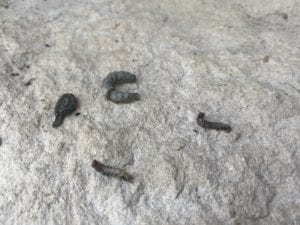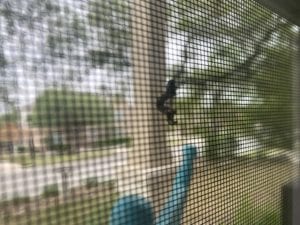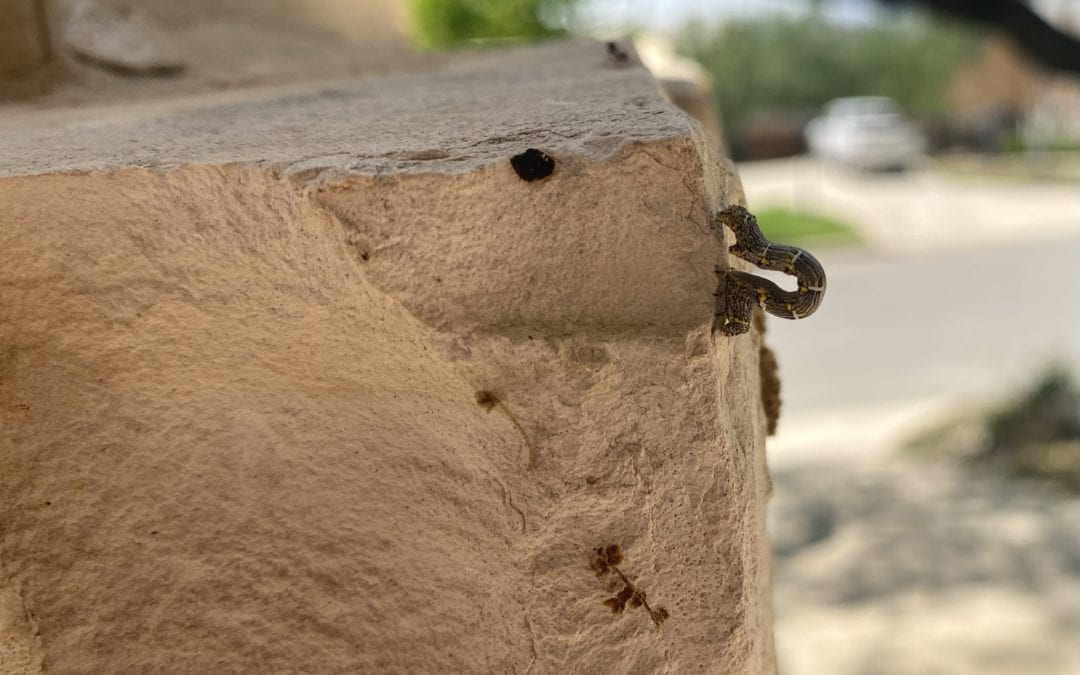Has anyone else recently found themselves going outside alone only to come back in with multiple “visitors” attached to their hair, clothing, or anything else that comes in contact with the multitudes of cankerworms dangling from silken threads in our trees? Cankerworms are everywhere right now! While their normal lifecycle makes them a regular occurrence each year, there are some years where everything lines up for an abundance of these annoying defoliaters. Guess what this year looks to be? As if oak pollen isn’t hard enough to get through, now we have to worry if it’s a strand of oak pollen tickling our neck, or a cankerworm hitching a ride! Today we’ll talk about what plants are most susceptible, and what treatment works best to control cankerworms.


Descriptions and Control of Cankerworms
Cankerworms are also called inchworms but they are really caterpillars. They are called inchworms because of the way they pull up the rear of their body and use it to gain momentum to thrust the front of their body forward. It’s rather entertaining to watch them move, but that is where their cuteness stops. These caterpillars can vary in color but are predominately marked with green, pale-yellow or brown stripes along the lengths of their 1 inch bodies. They also just happen to look like the tassles of oak pollen, ew! (See pic below and tell me at first glance that oak pollen doesn’t look like a cankerworm!) Larvae hatch from eggs just about the time that buds are breaking and leaves are developing on the trees in spring (and fall) and feed for 3 – 4 weeks. Cankerworms can quickly work to defoliate broad leaf trees.
It’s important to note that while defoliation can occur on all broad-leafed trees, it is the newly planted, newly transplanted, young or weakened trees that are more susceptible to any severe damage by cankerworms. Established, older trees may still experience some defoliation but will generally put out a fresh flush of foliage and not sustain long-term damage. All this being said, I did recently find some cankerworms happily munching away at my prized blue hibiscus petals! Not cool, inchworms, not cool!


Bt (Bacillus thuringiensis) is an organic spray that can help control cankerworms, although is best to know that this spray (like most insecticides) tends to work best when cankerworms are still young (when they are around a half inch long). The good news is that you don’t have to apply subsequent spray throughout the season because they do not produce multiple generations, although you may have to battle cankerworms again in the fall. Spinosad and Sevin are other products that work to eradicate caterpillars. Remember that butterflies and other beneficials are laying their eggs on many host plants and any insecticide, organic or not, can harm these beneficials as well. If you can avoid spraying, choose so.
What it comes down to is that you should be most on guard if you have newly planted, broad-leafed trees that appear to be getting munched on. Look for BB sized holes in leaves and a chewed on appearance to the foliage. Cankerworms will work on eating all of the leaf except for the center rib vein for the most part. If you are finding this on your young trees, you might want to spray to protect them from becoming weakened or enduring long-term damage. If you have this appearance on your foliage of otherwise healthy, established trees, skip the spray; this too shall pass.
Cankerworms are a temporary, heebie-jeebie invoking, nuisance for the most part. You’ll spend some time this April sweeping cankerworms off the exterior of your home, plucking them from your hair, feeling the squish between your toes when you walk barefoot, and twisting and writhing like a crazed maniac in the streets when you get tangled in their silk. And then they’ll be gone. We’ve gotten through a lot in the past year; we can get through this too.
~The Happy Gardener, Lisa Mulroy


Those inch worms or something is eating all the new leaves on my loquat plum trees. They were just coming back from the hard freeze.
Hi Laura,
Oh man, I’m sorry to hear that. I do think that after these worms move on (by May, hopefuly), that your loquat and plum trees will regenerate new foliage, especially if they are established trees. While I generally love all creatures, I have no qualms squishing these with my shoes anytime I come in contact with them.
How do you get rid of them organically, instead of using poison?
PG,
Hope the birds will feast on them, or wait them out. Bt is an organic product and the least toxic product we could recommend, but could still harm other beneficial caterpillars unfortunately.
Great informative and all too true description of the battle of the cankerworms in San Antonio the past few weeks – great sense of humor – we all have had those heebie geebies and won’t miss them at all!
The Feutz Family,
Thank you so much for taking the time to read the article and to comment! I wasn’t sure anyone would want to have anything to do with it once they saw the title and the picture! Ha! They are definitely a huge nuisance this spring, and I concur…..will NOT be missed!
I hate these worms! They give me the willies! I don’t even want to go outdoors. I check my husband and dog for worms after they’ve been outside. It’s just so disgusting this year cause there’s so many of them! All my neighbors know, when they hear me scream, that I’ve run into a worm or found one on me.
Hi Sue,
I AGREE! They are so icky! Take comfort in knowing that you are not alone in your disgust! Let’s all send out “get out of here vibes” and hope they move along soon!
Aloha,
Would you know if any of our local birds will eat a cankerworm?
Mahalo, y
Hi Yoli,
Yes, TAMU Agrilife Extension Service states that there are some of our local birds that seem to munch on them. As a matter of fact, I feel like I have had less visitors to my birdfeeders and I tie it directly to the abundance of cankerworms and leafrollers we are experiencing.
are these cankerworms, inch worms also called “oak leaf roller caterpillars” ?
Hi Gary,
They are two different species, but we are seeing BOTH in abundance this year.
Timely popular subject. An enjoyable article! Thanks!
Hi Marsha,
Thank you so much for taking the time to read the article! Truly appreciate it.
Is there anyway we can save this article on to Pinterest? The Pinterest logo is on the top bar but I can’t seem to get it to save a single article.
You should be able to log in to your Pinterest account, click the plus icon, add the “destination link” and click save from site to choose an image that pops up to use for your board. If you are having trouble doing these steps, it might have to do with your settings? Not really sure.